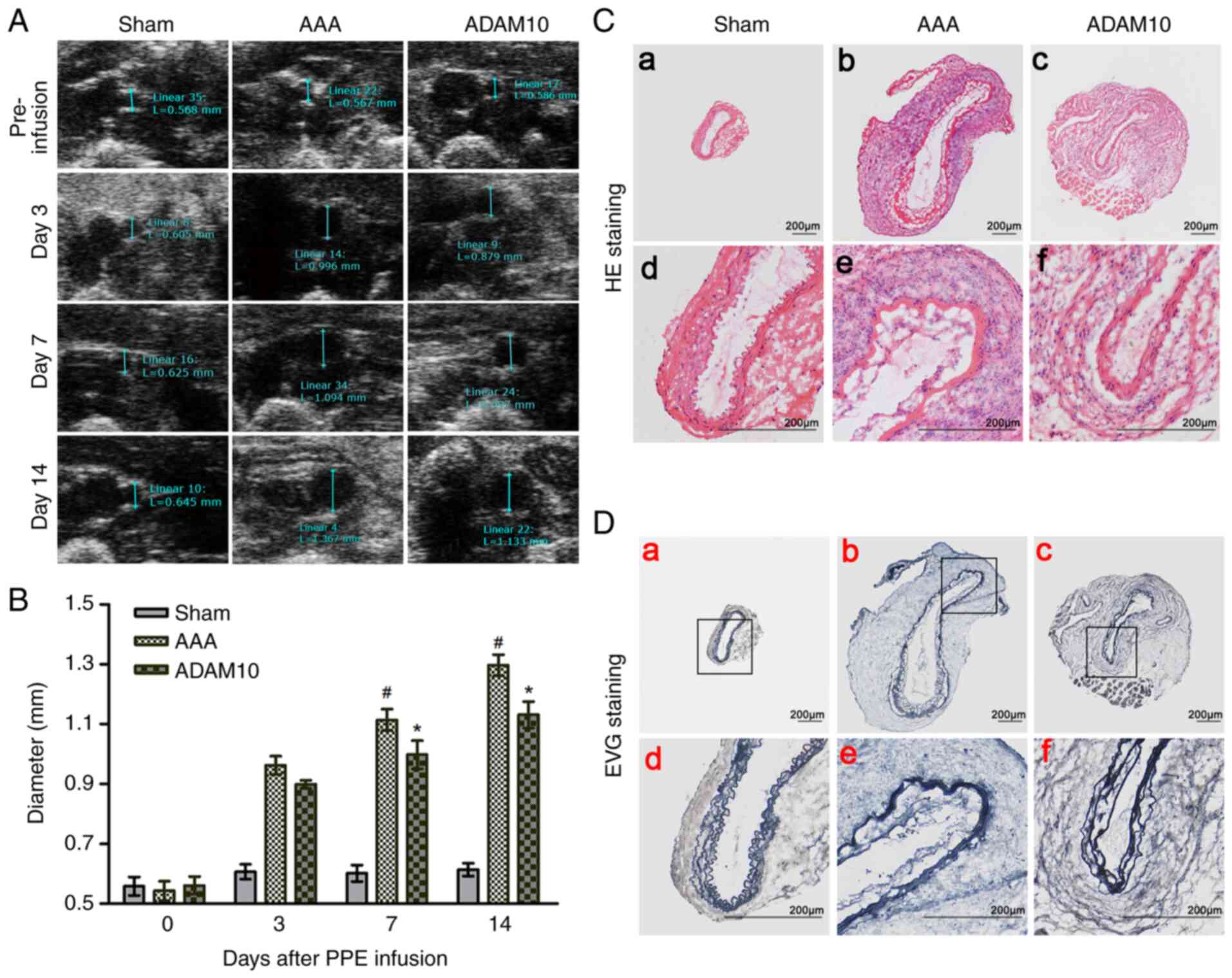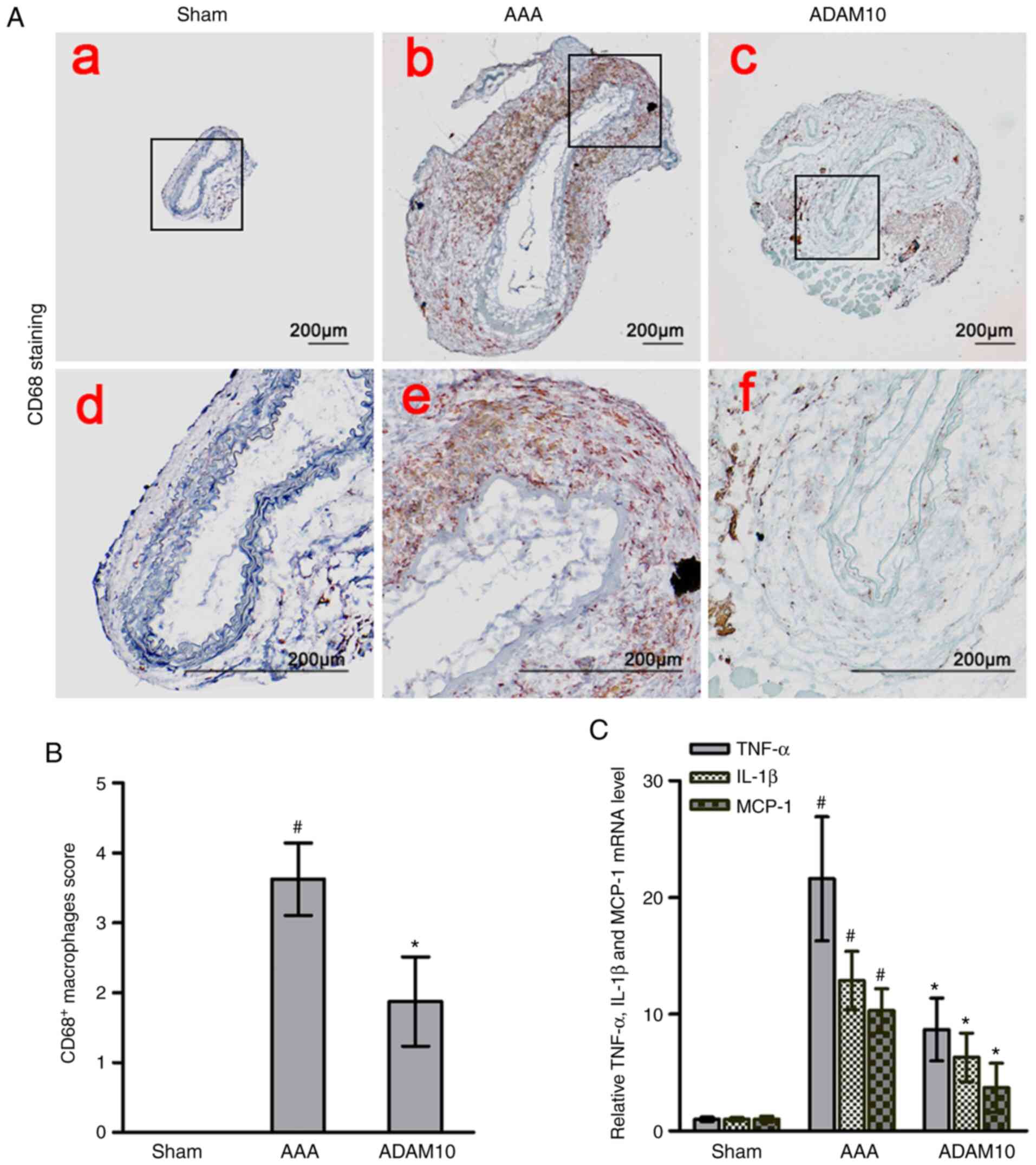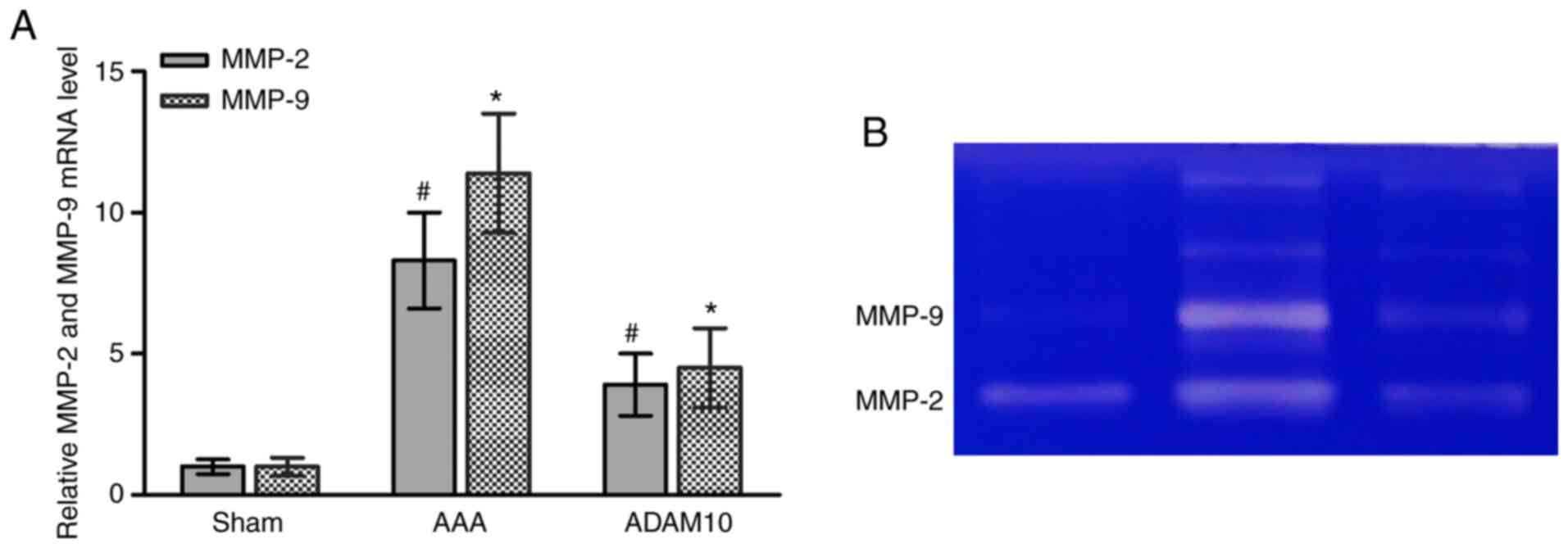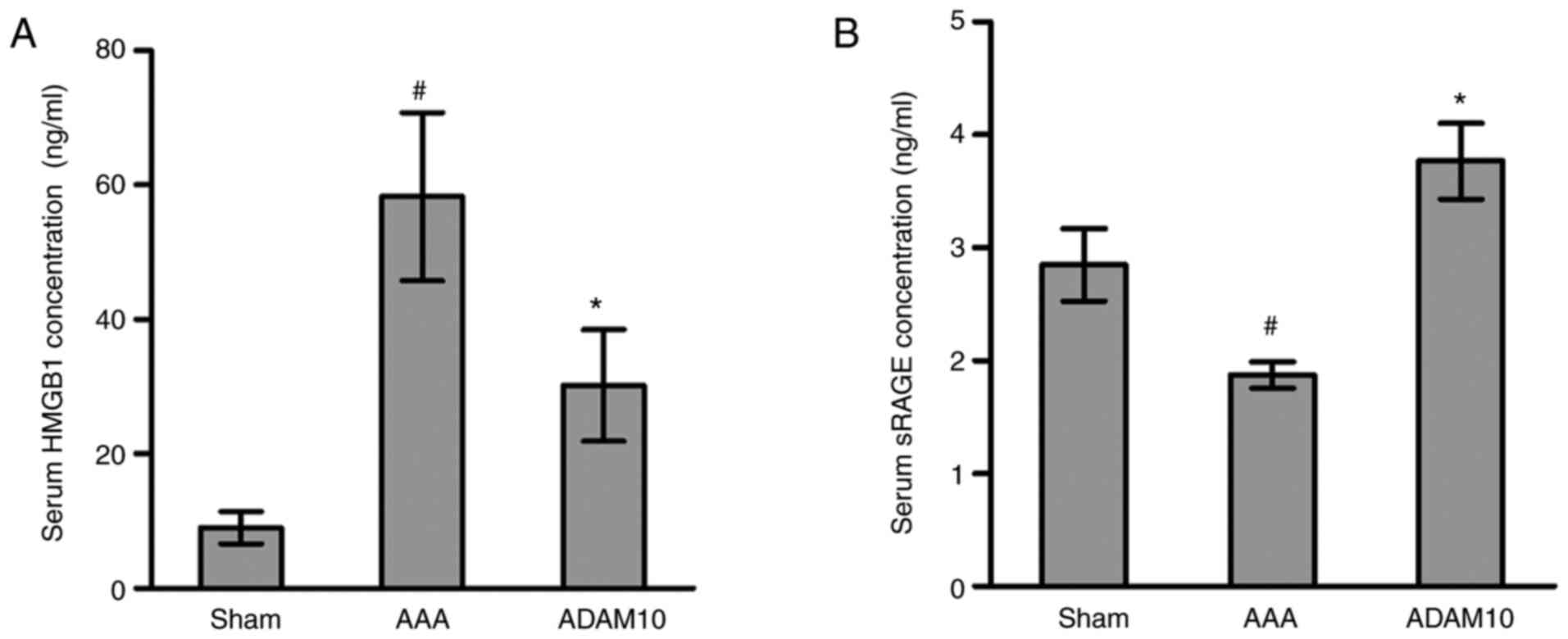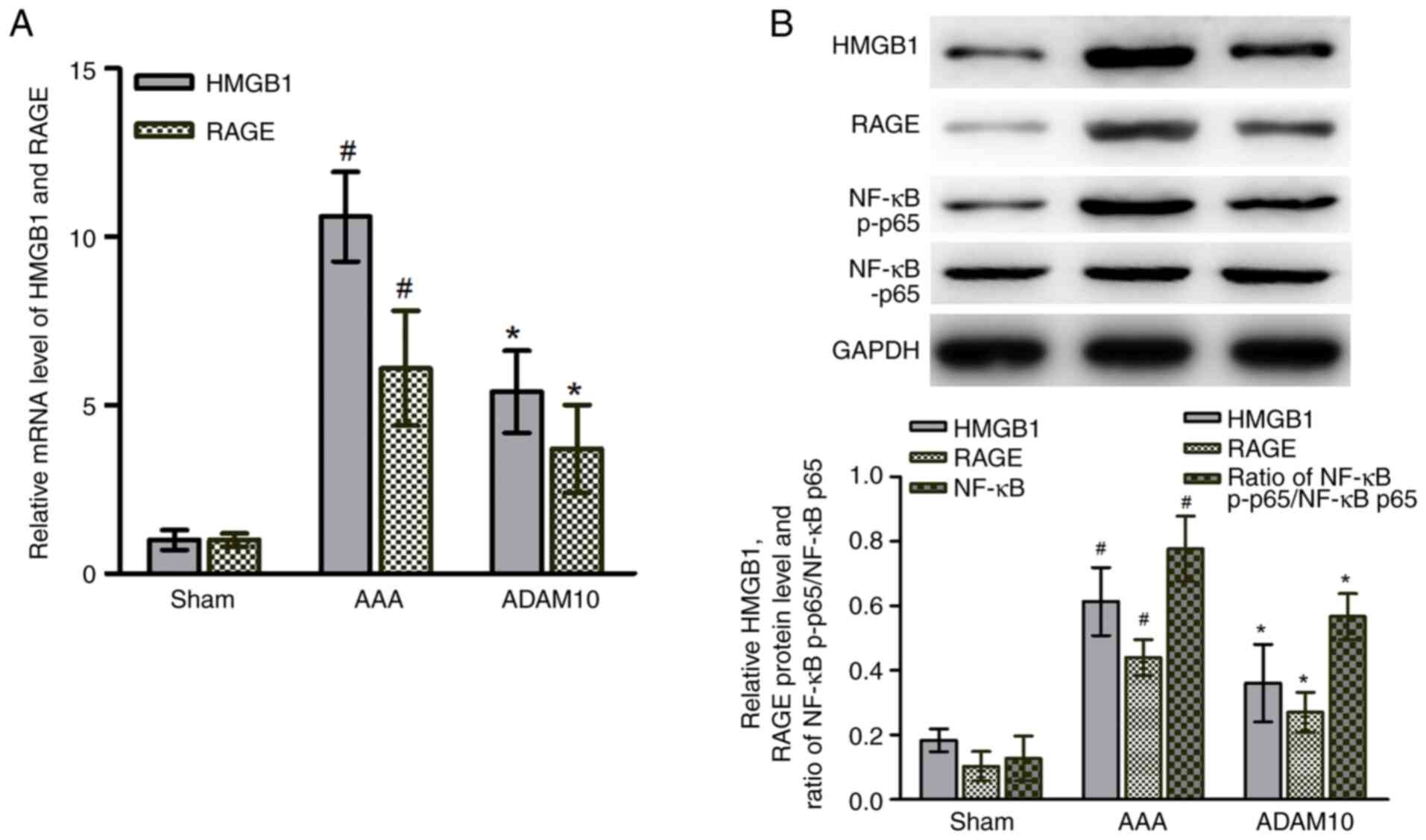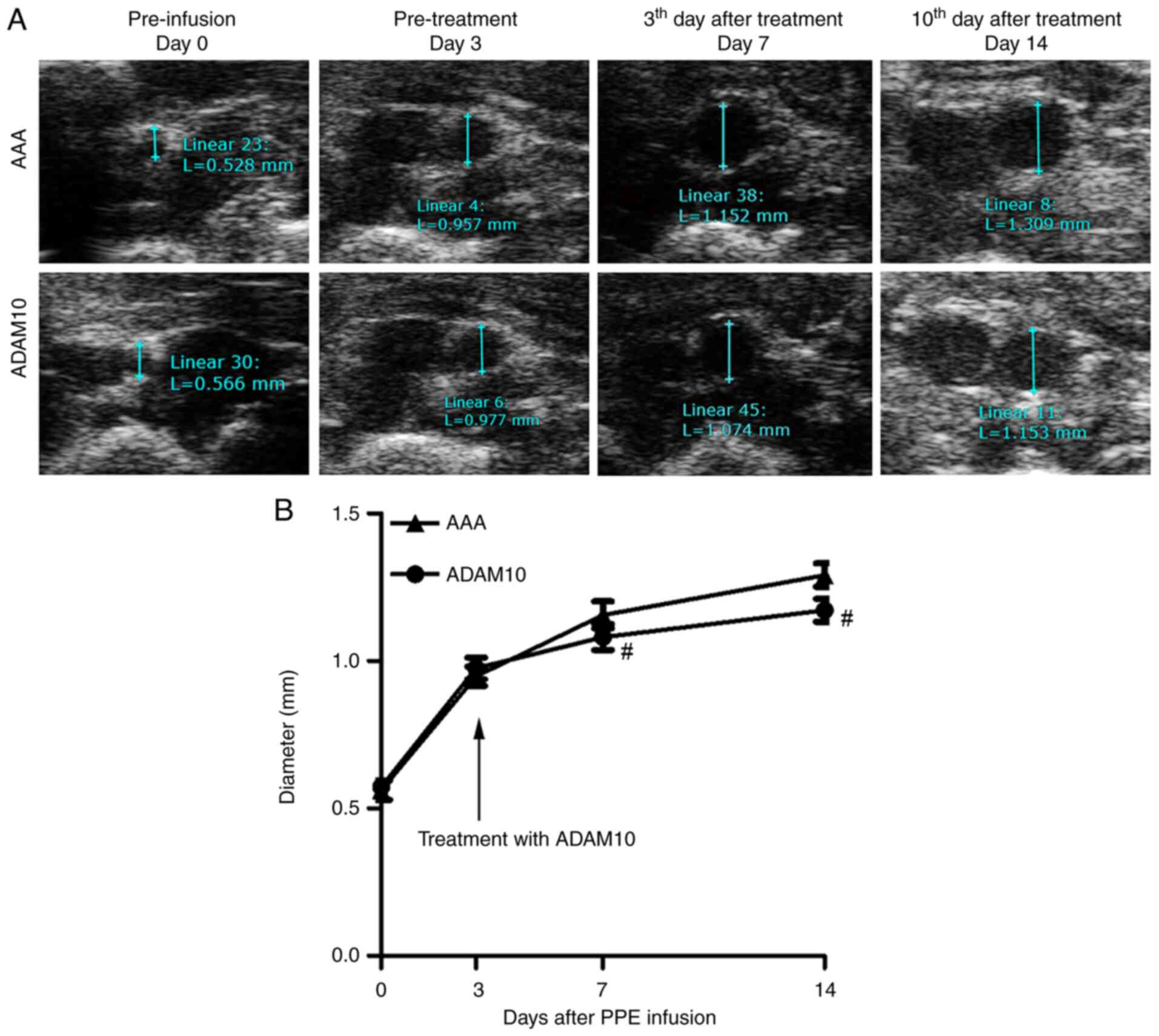|
1
|
Johnston KW, Rutherford RB, Tilson MD,
Shah DM, Hollier L and Stanley JC: Suggested standards for
reporting on arterial aneurysms. Subcommittee on Reporting
Standards for Arterial Aneurysms, Ad Hoc Committee on Reporting
Standards, Society for Vascular Surgery and North American Chapter,
International Society for Cardiovascular Surgery. J Vasc Surg.
13:452–458. 1991. View Article : Google Scholar : PubMed/NCBI
|
|
2
|
Sampson UK, Norman PE, Fowkes FG, Aboyans
V, Yanna Song, Harrell FE Jr, Forouzanfar MH, Naghavi M, Denenberg
JO, McDermott MM, et al: Global and regional burden of aortic
dissection and aneurysms: Mortality trends in 21 world regions,
1990 to 2010. Glob Heart. 9:171–180.e10. 2014. View Article : Google Scholar : PubMed/NCBI
|
|
3
|
Ghaferi AA, Birkmeyer JD and Dimick JB:
Variation in hospital mortality associated with inpatient surgery.
N Engl J Med. 361:1368–1375. 2009. View Article : Google Scholar : PubMed/NCBI
|
|
4
|
Shang T, Ran F, Qiao Q, Liu Z and Liu CJ:
Tanshinone IIA attenuates elastase-induced AAA in rats via
inhibition of MyD88-dependent TLR-4 signaling. Vasa. 43:39–46.
2014. View Article : Google Scholar : PubMed/NCBI
|
|
5
|
Golledge J: Abdominal aortic aneurysm:
Update on pathogenesis and medical treatments. Nat Rev Cardiol.
16:225–242. 2019. View Article : Google Scholar : PubMed/NCBI
|
|
6
|
Raffort J, Lareyre F, Clément M,
Hassen-Khodja R, Chinetti G and Mallat Z: Monocytes and macrophages
in abdominal aortic aneurysm. Nat Rev Cardiol. 14:457–471. 2017.
View Article : Google Scholar : PubMed/NCBI
|
|
7
|
Neeper M, Schmidt AM, Brett J, Yan SD,
Wang F, Pan YC, Elliston K, Stern D and Shaw A: Cloning and
expression of a cell surface receptor for advanced glycosylation
end products of proteins. J Biol Chem. 267:14998–15004. 1992.
View Article : Google Scholar : PubMed/NCBI
|
|
8
|
Kierdorf K and Fritz G: RAGE regulation
and signaling in inflammation and beyond. J Leukoc Biol. 94:55–68.
2013. View Article : Google Scholar : PubMed/NCBI
|
|
9
|
Piperi C, Adamopoulos C, Dalagiorgou G,
Diamanti-Kandarakis E and Papavassiliou AG: Crosstalk between
advanced glycation and endoplasmic reticulum stress: Emerging
therapeutic targeting for metabolic diseases. J Clin Endocrinol
Metab. 97:2231–2242. 2012. View Article : Google Scholar : PubMed/NCBI
|
|
10
|
Huttunen HJ, Fages C and Rauvala H:
Receptor for advanced glycation end products (RAGE)-mediated
neurite outgrowth and activation of NF-kappaB require the
cytoplasmic domain of the receptor but different downstream
signaling pathways. J Biol Chem. 274:19919–19924. 1999. View Article : Google Scholar : PubMed/NCBI
|
|
11
|
Santilli F, Vazzana N, Bucciarelli LG and
Davì G: Soluble forms of RAGE in human diseases: Clinical and
therapeutical implications. Curr Med Chem. 16:940–952. 2009.
View Article : Google Scholar : PubMed/NCBI
|
|
12
|
van Zoelen MA, Yang H, Florquin S, Meijers
JC, Akira S, Arnold B, Nawroth PP, Bierhaus A, Tracey KJ and van
der Poll T: Role of toll-like receptors 2 and 4, and the receptor
for advanced glycation end products in high-mobility group box
1-induced inflammation in vivo. Shock. 31:280–284. 2009. View Article : Google Scholar : PubMed/NCBI
|
|
13
|
Paudel YN, Angelopoulou E, Piperi C,
Balasubramaniam VRMT, Othman I and Shaikh MF: Enlightening the role
of high mobility group box 1 (HMGB1) in inflammation: Updates on
receptor signalling. Eur J Pharmacol. 858:1724872019. View Article : Google Scholar : PubMed/NCBI
|
|
14
|
Andersson U, Yang H and Harris H:
High-mobility group box 1 protein (HMGB1) operates as an alarmin
outside as well as inside cells. Semin Immunol. 38:40–48. 2018.
View Article : Google Scholar : PubMed/NCBI
|
|
15
|
Oozawa S, Mori S, Kanke T, Takahashi H,
Liu K, Tomono Y, Asanuma M, Miyazaki I, Nishibori M and Sano S:
Effects of HMGB1 on ischemia-reperfusion injury in the rat heart.
Circ J. 72:1178–1184. 2008. View Article : Google Scholar : PubMed/NCBI
|
|
16
|
Andrassy M, Volz HC, Igwe JC, Funke B,
Eichberger SN, Kaya Z, Buss S, Autschbach F, Pleger ST, Lukic IK,
et al: High-mobility group box-1 in ischemia-reperfusion injury of
the heart. Circulation. 117:3216–3226. 2008. View Article : Google Scholar : PubMed/NCBI
|
|
17
|
Hamada T, Torikai M, Kuwazuru A, Tanaka M,
Horai N, Fukuda T, Yamada S, Nagayama S, Hashiguchi K, Sunahara N,
et al: Extracellular high mobility group box chromosomal protein 1
is a coupling factor for hypoxia and inflammation in arthritis.
Arthritis Rheum. 58:2675–2685. 2008. View Article : Google Scholar : PubMed/NCBI
|
|
18
|
Golledge J, Muller J, Daugherty A and
Norman P: Abdominal aortic aneurysm: Pathogenesis and implications
for management. Arterioscler Thromb Vasc Biol. 26:2605–2613. 2006.
View Article : Google Scholar : PubMed/NCBI
|
|
19
|
Saftig P and Reiss K: The ‘A Disintegrin
And Metalloproteases’ ADAM10 and ADAM17: Novel drug targets with
therapeutic potential? Eur J Cell Biol. 90:527–535. 2011.
View Article : Google Scholar : PubMed/NCBI
|
|
20
|
Donners MM, Wolfs IM, Olieslagers S,
Mohammadi-Motahhari Z, Tchaikovski V, Heeneman S, van Buul JD,
Caolo V, Molin DG, Post MJ and Waltenberger J: A disintegrin and
metalloprotease 10 is a novel mediator of vascular endothelial
growth factor-induced endothelial cell function in angiogenesis and
is associated with atherosclerosis. Arterioscler Thromb Vasc Biol.
30:2188–2195. 2010. View Article : Google Scholar : PubMed/NCBI
|
|
21
|
Maretzky T, Reiss K, Ludwig A, Buchholz J,
Scholz F, Proksch E, de Strooper B, Hartmann D and Saftig P: ADAM10
mediates E-cadherin shedding and regulates epithelial cell-cell
adhesion, migration, and beta-catenin translocation. Proc Natl Acad
Sci USA. 102:9182–9187. 2005. View Article : Google Scholar : PubMed/NCBI
|
|
22
|
Raucci A, Cugusi S, Antonelli A, Barabino
SM, Monti L, Bierhaus A, Reiss K, Saftig P and Bianchi ME: A
soluble form of the receptor for advanced glycation endproducts
(RAGE) is produced by proteolytic cleavage of the membrane-bound
form by the sheddase a disintegrin and metalloprotease 10 (ADAM10).
FASEB J. 22:3716–3727. 2008. View Article : Google Scholar : PubMed/NCBI
|
|
23
|
Jiao T, Yao Y, Zhang B, Hao DC, Sun QF, Li
JB, Yuan C, Jing B, Wang YP and Wang HY: Role of MicroRNA-103a
targeting ADAM10 in abdominal aortic aneurysm. Biomed Res Int.
2017:96458742017. View Article : Google Scholar : PubMed/NCBI
|
|
24
|
National Research Council (US) Institute
for Laboratory Animal Research, . Guide for the care and use of
laboratory animals. Washington (DC): National Academies Press;
1996
|
|
25
|
Anidjar S, Salzmann JL, Gentric D, Lagneau
P, Camilleri JP and Michel JB: Elastase-induced experimental
aneurysms in rats. Circulation. 82:973–981. 1990. View Article : Google Scholar : PubMed/NCBI
|
|
26
|
Zhang F, Kent KC, Yamanouchi D, Zhang Y,
Kato K, Tsai S, Nowygrod R, Schmidt AM and Liu B: Anti-receptor for
advanced glycation end products therapies as novel treatment for
abdominal aortic aneurysm. Ann Surg. 250:416–423. 2009. View Article : Google Scholar : PubMed/NCBI
|
|
27
|
Livak KJ and Schmittgen TD: Analysis of
relative gene expression data using real-time quantitative PCR and
the 2(-Delta Delta C(T)) method. Methods. 25:402–408. 2001.
View Article : Google Scholar : PubMed/NCBI
|
|
28
|
Li G, Yang L, Yuan H, Liu Y, He Y, Wu X
and Jin X: Cold-inducible RNA-binding protein plays a central role
in the pathogenesis of abdominal aortic aneurysm in a murine
experimental model. Surgery. 159:1654–1667. 2016. View Article : Google Scholar : PubMed/NCBI
|
|
29
|
Snoek-van Beurden PA and Von den Hoff JW:
Zymographic techniques for the analysis of matrix
metalloproteinases and their inhibitors. Biotechniques. 38:73–83.
2005. View Article : Google Scholar : PubMed/NCBI
|
|
30
|
Murray PJ and Wynn TA: Protective and
pathogenic functions of macrophage subsets. Nat Rev Immunol.
11:723–737. 2011. View Article : Google Scholar : PubMed/NCBI
|
|
31
|
Shiraya S, Miyake T, Aoki M, Yoshikazu F,
Ohgi S, Nishimura M, Ogihara T and Morishita R: Inhibition of
development of experimental aortic abdominal aneurysm in rat model
by atorvastatin through inhibition of macrophage migration.
Atherosclerosis. 202:34–40. 2009. View Article : Google Scholar : PubMed/NCBI
|
|
32
|
Lindholt JS, Henneberg EW, Juul S and
Fasting H: Impaired results of a randomised double blinded clinical
trial of propranolol versus placebo on the expansion rate of small
abdominal aortic aneurysms. Int Angiol. 18:52–57. 1999.PubMed/NCBI
|
|
33
|
Morris DR, Cunningham MA, Ahimastos AA,
Kingwell BA, Pappas E, Bourke M, Reid CM, Stijnen T, Dalman RL,
Aalami OO, et al: TElmisartan in the management of abDominal aortic
aneurYsm (TEDY): The study protocol for a randomized controlled
trial. Trials. 16:2742015. View Article : Google Scholar : PubMed/NCBI
|
|
34
|
Meijer CA, Stijnen T, Wasser MN, Hamming
JF, van Bockel JH and Lindeman JH; Pharmaceutical Aneurysm
Stabilisation Trial Study Group, : Doxycycline for stabilization of
abdominal aortic aneurysms: A randomized trial. Ann Intern Med.
159:815–823. 2013. View Article : Google Scholar : PubMed/NCBI
|
|
35
|
Kokje VB, Hamming JF and Lindeman JH:
Editor's Choice-pharmaceutical management of small abdominal aortic
aneurysms: A systematic review of the clinical evidence. Eur J Vasc
Endovasc Surg. 50:702–713. 2015. View Article : Google Scholar : PubMed/NCBI
|
|
36
|
Busch A, Holm A, Wagner N, Ergün S,
Rosenfeld M, Otto C, Baur J, Kellersmann R and Lorenz U: Extra- and
intraluminal elastase induce morphologically distinct abdominal
aortic aneurysms in mice and thus represent specific subtypes of
human disease. J Vasc Res. 53:49–57. 2016. View Article : Google Scholar : PubMed/NCBI
|
|
37
|
Busch A, Chernogubova E, Jin H, Meurer F,
Eckstein HH, Kim M and Maegdefessel L: Four surgical modifications
to the classic elastase perfusion aneurysm model enable
haemodynamic alterations and extended elastase perfusion. Eur J
Vasc Endovasc Surg. 56:102–109. 2018. View Article : Google Scholar : PubMed/NCBI
|
|
38
|
Johnston WF, Salmon M, Su G, Lu G,
Ailawadi G and Upchurch GR Jr: Aromatase is required for female
abdominal aortic aneurysm protection. J Vasc Surg.
61:1565–74.e1-e4. 2015. View Article : Google Scholar : PubMed/NCBI
|
|
39
|
Wu H, Li R, Pei LG, Wei ZH, Kang LN, Wang
L, Xie J and Xu B: Emerging role of high mobility group Box-1 in
thrombosis-related diseases. Cell Physiol Biochem. 47:1319–1337.
2018. View Article : Google Scholar : PubMed/NCBI
|
|
40
|
Bae JS: Role of high mobility group box 1
in inflammatory disease: Focus on sepsis. Arch Pharm Res.
35:1511–1523. 2012. View Article : Google Scholar : PubMed/NCBI
|
|
41
|
Ding HS and Yang J: High mobility group
box-1 and cardiovascular diseases. Saudi Med J. 31:486–489.
2010.PubMed/NCBI
|
|
42
|
van Beijnum JR, Buurman WA and Griffioen
AW: Convergence and amplification of toll-like receptor (TLR) and
receptor for advanced glycation end products (RAGE) signaling
pathways via high mobility group B1 (HMGB1). Angiogenesis.
11:91–99. 2008. View Article : Google Scholar : PubMed/NCBI
|
|
43
|
Hreggvidsdottir HS, Ostberg T, Wähämaa H,
Schierbeck H, Aveberger AC, Klevenvall L, Palmblad K, Ottosson L,
Andersson U and Harris HE: The alarmin HMGB1 acts in synergy with
endogenous and exogenous danger signals to promote inflammation. J
Leukoc Biol. 86:655–662. 2009. View Article : Google Scholar : PubMed/NCBI
|
|
44
|
Sims GP, Rowe DC, Rietdijk ST, Herbst R
and Coyle AJ: HMGB1 and RAGE in inflammation and cancer. Annu Rev
Immunol. 28:367–388. 2010. View Article : Google Scholar : PubMed/NCBI
|
|
45
|
Bierhaus A, Humpert PM, Morcos M, Wendt T,
Chavakis T, Arnold B, Stern DM and Nawroth PP: Understanding RAGE,
the receptor for advanced glycation end products. J Mol Med (Berl).
83:876–886. 2005. View Article : Google Scholar : PubMed/NCBI
|
|
46
|
Dattilo BM, Fritz G, Leclerc E, Kooi CW,
Heizmann CW and Chazin WJ: The extracellular region of the receptor
for advanced glycation end products is composed of two independent
structural units. Biochemistry. 46:6957–6970. 2007. View Article : Google Scholar : PubMed/NCBI
|
|
47
|
Basta G, Lazzerini G, Massaro M, Simoncini
T, Tanganelli P, Fu C, Kislinger T, Stern DM, Schmidt AM and De
Caterina R: Advanced glycation end products activate endothelium
through signal-transduction receptor RAGE: A mechanism for
amplification of inflammatory responses. Circulation. 105:816–822.
2002. View Article : Google Scholar : PubMed/NCBI
|
|
48
|
Sung JY, Chung W, Kim AJ, Kim HS, Ro H,
Chang JH, Lee HH and Jung JY: Calcitriol treatment increases serum
levels of the soluble receptor of advanced glycation end products
in hemodialysis patients with secondary hyperparathyroidism. Tohoku
J Exp Med. 230:59–66. 2013. View Article : Google Scholar : PubMed/NCBI
|
|
49
|
Soro-Paavonen A, Watson AM, Li J, Paavonen
K, Koitka A, Calkin AC, Barit D, Coughlan MT, Drew BG, Lancaster
GI, et al: Receptor for advanced glycation end products (RAGE)
deficiency attenuates the development of atherosclerosis in
diabetes. Diabetes. 57:2461–2469. 2008. View Article : Google Scholar : PubMed/NCBI
|
|
50
|
Zhang L, Bukulin M, Kojro E, Roth A, Metz
VV, Fahrenholz F, Nawroth PP, Bierhaus A and Postina R: Receptor
for advanced glycation end products is subjected to protein
ectodomain shedding by metalloproteinases. J Biol Chem.
283:35507–35516. 2008. View Article : Google Scholar : PubMed/NCBI
|
|
51
|
Detzen L, Cheng B, Chen CY, Papapanou PN
and Lalla E: Soluble forms of the receptor for advanced glycation
endproducts (RAGE) in periodontitis. Sci Rep. 9:81702019.
View Article : Google Scholar : PubMed/NCBI
|
|
52
|
Ramasamy R and Schmidt AM: Schmidt,
Soluble RAGE: Therapy and biomarker in unraveling the RAGE axis in
chronic disease and aging. Biochem Pharmacol. 79:1379–1386. 2010.
View Article : Google Scholar : PubMed/NCBI
|
|
53
|
Lee EJ and Park JH: Receptor for advanced
glycation endproducts (RAGE), its ligands, and soluble RAGE:
Potential biomarkers for diagnosis and therapeutic targets for
human renal diseases. Genomics Inform. 11:224–229. 2013. View Article : Google Scholar : PubMed/NCBI
|
|
54
|
Baud V and Karin M: Is NF-kappaB a good
target for cancer therapy? Hopes and pitfalls. Nat Rev Drug Discov.
8:33–40. 2009. View Article : Google Scholar : PubMed/NCBI
|
|
55
|
Nakashima H, Aoki M, Miyake T, Kawasaki T,
Iwai M, Jo N, Oishi M, Kataoka K, Ohgi S, Ogihara T, et al:
Inhibition of experimental abdominal aortic aneurysm in the rat by
use of decoy oligodeoxynucleotides suppressing activity of nuclear
factor kappaB and ets transcription factors. Circulation.
109:132–138. 2004. View Article : Google Scholar : PubMed/NCBI
|
|
56
|
Chen YJ, Chan DC, Chiang CK, Wang CC, Yang
TH, Lan KC, Chao SC, Tsai KS, Yang RS, Liu SH, et al: Advanced
glycation end-products induced VEGF production and inflammatory
responses in human synoviocytes via RAGE-NF-κB pathway activation.
J Orthop Res. 34:791–800. 2016. View Article : Google Scholar : PubMed/NCBI
|
|
57
|
Medeiros MC, Frasnelli SC, Bastos Ade S,
Orrico SR and Rossa C Jr: Modulation of cell proliferation,
survival and gene expression by RAGE and TLR signaling in cells of
the innate and adaptive immune response: Role of p38 MAPK and
NF-KB. J Appl Oral Sci. 22:185–193. 2014. View Article : Google Scholar : PubMed/NCBI
|
|
58
|
Lappas M, Permezel M and Rice GE: Advanced
glycation endproducts mediate pro-inflammatory actions in human
gestational tissues via nuclear factor-kappaB and extracellular
signal-regulated kinase 1/2. J Endocrinol. 193:269–277. 2007.
View Article : Google Scholar : PubMed/NCBI
|
|
59
|
Hofmann MA, Drury S, Fu C, Qu W, Taguchi
A, Lu Y, Avila C, Kambham N, Bierhaus A, Nawroth P, et al: RAGE
mediates a novel proinflammatory axis: A central cell surface
receptor for S100/calgranulin polypeptides. Cell. 97:889–901. 1999.
View Article : Google Scholar : PubMed/NCBI
|















